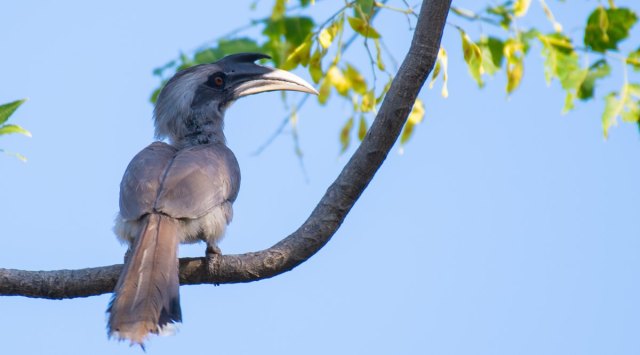- India
- International
Birds without Borders: Indian grey hornbill, the conjugal love birds that love Gujarat cities
Out of 54 species of hornbills globally, nine are found in India and only one species, Indian grey hornbill, is found in Gujarat. They are common residents of north, central and south Gujarat regions.
 Indian grey hornbill (scientific name: Ocyceros birostris) name is derived from its unique horn-like beak. (Express photo)
Indian grey hornbill (scientific name: Ocyceros birostris) name is derived from its unique horn-like beak. (Express photo) Indian grey hornbill is known for its conjugal love relationship. The level of trust and bond they share is simply amazing. In Gujarati, the male Indian grey hornbill is fondly called vahughelo, meaning, a doting husband. Why? Because once the pair finds a nesting site in a tree hollow, the female sheds her flight feathers and stays inside the nest to hatch the eggs. Then, the male brings mud pellets to the female and she seals the entrance of the nest using them with her excreta. She keeps only one vertical slit open at the entrance to bring her beak out to get the food and shoot faeces far outside from that crack only. Thus, she entirely trusts her partner with her food requirements for about two months while using her shed feathers for layering the nest. Everyday male travels long distances to collect food and feeds the regurgitated food to the female. Like a young lover will go, “Crazy for you! I trust you with my life!”
They mate with one partner at a time. By the time the chicks are grown, the mother regrows her flight feathers. She breaks opens the entrance with her beak and then they feed the young ones together.
Indian grey hornbill (scientific name: Ocyceros birostris) name refers to the unique horn-like beak of this species of birds. Additionally, the male has a noticeable pointed blackish casque at the upper mandible, whereas the female has a less prominent casque. The beak is brownish-black and ivory-white. The upper body of the Indian grey hornbill is silverish grey. The belly is whitish and the eyes are brown-red. There is bare skin around the eyes, and the head is covered with a silver-white plume.
Indian grey hornbills mainly eat fruits and berries. Due to that, they help in dispersing seeds and expanding forests. Particularly, they are noted in dispersing fig tree seeds. Moreover, they feed on insects, lizards, snails, rodents and bird chicks.
During flight, the bird flaps its wings rapidly then glides then again rapidly flaps and glides. White tips of feathers and dark bands of whitish tail are quite prominent in flight. They usually sit on the topmost branches of the trees, so difficult to spot while being under the tree. They keep moving from one branch to other, enjoying meal of fruits.

Out of 54 species of hornbills globally, nine are found in India and only one species, Indian grey hornbill, is found in Gujarat. They are common residents of north, central and south Gujarat regions.
Saurashtra has a few records of Indian grey hornbills and they are uncommon in Kutch. Notably, the Indian grey hornbills have got accustomed to urban areas. Therefore, they are found in big cities such as Ahmedabad and Gandhinagar. This photo, clicked on Ahmedabad University campus in Ahmedabad, Gujarat is the proof. They are usually found in a pair or small group. It should be noted that Indian grey hornbills have changed their moving pattern in Gujarat. Before 1936, they were plentiful in the Gir forest during winter months which is reduced to a few isolated records in recent decades though their local migration patten, if any, remains a phenomenon to be studied.
Indian grey hornbill is 50 centimetres in length, weighs about 370 to 400 grams and lives for a decade. It lays 2 to 4 eggs. Their population is stable. They are categorised as Least Concern on the IUCN Red List.
Indian grey hornbill has also achieved an honour to be the state bird of Chandigarh.
Next time when you are in a park, keep an eye out for a greyish-looking bird having a horn-like bill. They are usually found perching on neem, pipal, banyan and gulmohar trees.
(Dr Jayendra M Bhalodiya is an assistant professor at Ahmedabad University. He is affiliatedwith Bird Conservation Society, Gujarat and Eco Friends Gujarat.)
May 22: Latest News
- 01
- 02
- 03
- 04
- 05





































